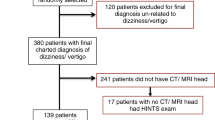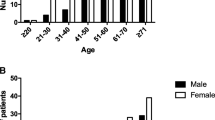Abstract
Acute dizziness (including vertigo) is a common reason to visit the emergency room, and imaging with head CT is often performed initially to exclude a central cause. In this study, consecutive patients presenting with dizziness and undergoing head CT were retrospectively reviewed to determine diagnostic yield. Four hundred forty-eight consecutive head CTs in a representative sample of dizzy emergency room (ER) patients, including patients with other neurological symptoms, were reviewed to identify an acute or subacute cause for acute dizziness along with the frequency and modalities used in follow-up imaging. The diagnostic yield for head CT ordered in the ER for acute dizziness is low (2.2 %; 1.6 % for emergent findings), but MRI changes the diagnosis up to 16 % of the time, acutely in 8 % of cases. Consistent with the American College of Radiology appropriateness criteria and the literature, this study suggests a low diagnostic yield for CT in the evaluation of acute dizziness but an important role for MRI in appropriately selected cases.
Similar content being viewed by others
Notes
Intracranial stenosis revealed on follow-up imaging was classified as a new acute finding if it was associated with TIA-like symptoms; otherwise, it was considered sub-acute.
References
Kerber KA, Brown DL, Lisabeth LD et al (2006) Stroke among patients with dizziness, vertigo, and imbalance in the emergency department: a population-based study. Stroke 37:2484
Chase M, Joyce NR, Carney E et al (2011) ED patients with vertigo: can we identify clinical factors associated with acute stroke? Am J Emerg Med 30(4):587–591
Kroenke K, Hoffman RM, Einstadter D (2000) How common are various causes of dizziness? A critical review. South Med J 93:160
Seemungal BM, Bronstein AM (2008) A practical approach to acute vertigo. Pract Neurol 8:211
Kim AS, Sidney S, Klingman JG et al (2011) Practice variation in neuroimaging to evaluate dizziness in the ED. Am J Emerg Med 30(5):665–672
Wasay M, Dubey N, Bakshi R (2005) Dizziness and yield of emergency head CT scan: is it cost effective? Emerg Med J 22:312
Chalela JA, Kidwell CS, Nentwich LM et al (2007) Magnetic resonance imaging and computed tomography in emergency assessment of patients with suspected acute stroke: a prospective comparison. Lancet 369:293
Kerber KA (2007) Vertigo and dizziness in the emergency department. Emerg Med Clin N Am 27(1):39–50
Labuguen RH (2006) Initial evaluation of vertigo. Am Fam Physician 73:244
Edlow JA, Newman-Toker DE, Savitz SI (2008) Diagnosis and initial management of cerebellar infarction. Lancet Neurol 7:951
Fiebach JB, Schellinger PD, Gass A et al (2004) Stroke magnetic resonance imaging is accurate in hyperacute intracerebral hemorrhage: a multicenter study on the validity of stroke imaging. Stroke 35:502
American College of Radiology (2008) American College of Radiology (ACR) appropriateness criteria: vertigo and hearing loss.
Acknowledgments
The authors would like to thank Jack Collins, Sarah Orrin, Jay Patel, Danny Cheng, and Will Whetsell for their assistance with data collection. Our work was supported by the Arthur Quern fellowship and the University of Chicago Pritzker School of Medicine Summer Research Program.
Author information
Authors and Affiliations
Corresponding author
Additional information
Summary statement
Head CT was found to have a low diagnostic yield for patients presenting to the emergency room with dizziness.
Rights and permissions
About this article
Cite this article
Lawhn-Heath, C., Buckle, C., Christoforidis, G. et al. Utility of head CT in the evaluation of vertigo/dizziness in the emergency department. Emerg Radiol 20, 45–49 (2013). https://doi.org/10.1007/s10140-012-1071-y
Received:
Accepted:
Published:
Issue Date:
DOI: https://doi.org/10.1007/s10140-012-1071-y




